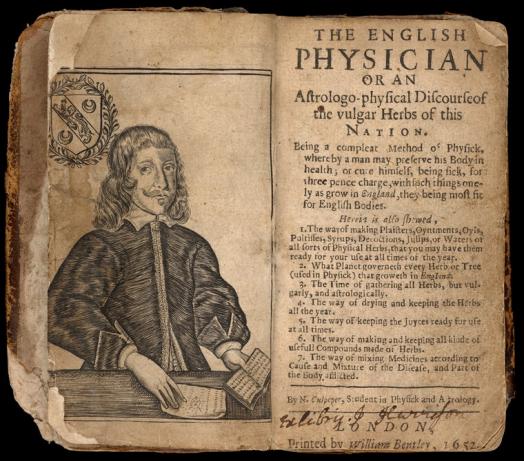
Titlepage & frontispiece to Nicholas Culpeper, The English physician (London, 1652)
We compiled initial bibliographic data from the English Short Title Catalogue (ESTC) and then enriched it; we combed the ESTC for all works on heath and healing, including those that might be difficult to find via keywords. To help our users find texts of interest, we’ve coded each book with terms describing topic, genre, and occupation of the author (when stated in the text). We’ve used today’s terms for topics, such as “reproduction” and “disability”, so that readers unfamiliar with early modern English terms can find books they want. For genres, we have used terms that would be familiar to our authors, describing the kind of book that they were aiming to produce, and similarly, used authors’ own descriptions of their occupations. Genres, such as “treatise” or “dispensatory,” may be less familiar to students. In both cases, there are robust definitions of topics, genres, and occupations to guide searchers. Basic and nested searches on a wide range of terms, such as author, title keyword, publisher, etc., will also guide readers to identify relevant texts.
All of the texts in the database are in English, but the world they encompass is much broader than that of the British Isles, because so many of the works are translations from Continental texts. Paracelsus, for example, the 16th century radical German healer who revolutionized therapeutics, can be read in English; so too can Felix Platter the noted anatomist; Italian books of secrets can also be read in translation. For teachers looking for primary sources to assign to students, such English translations offer a wealth of opportunity.
Once texts have been identified, the work of interpretation begins. Here our site offers a range of short contextual essays, written by leading scholars, to help readers begin to understand the worlds of health and healing within which their texts would have been written and read. Essays tackle the nuts and bolts of medical ideas; the structures of medical work; the basics of printing and illustrating books; ailments such as plague and venereal diseases; and a host of other topics. Each essay contains links to exemplary primary sources in the database and a short list of secondary sources to help a researcher get going on a topic.
In addition to exploring specific texts or topics, users of the site can generate data about the shape of early medical publishing using data visualization tools. For example, with the Platin Histogram tool, students can create timelines by date of publication for any kind of searchable category; topic, author, etc. Similarly, with Voyant, word clouds can be created for different categories of books, authors, time periods, or any other searchable term. Network diagrams created with Palladio can map how publishers or authors of topics were connected, creating new forms of data to be analyzed, and new research questions.